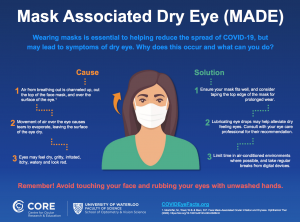ECPs Should Ask Patients About Symptoms, Offer Tips to Mitigate Issue
WATERLOO, Ontario, August 31, 2020—Widespread use of face masks has been determined essential to combat COVID-19’s spread, yet is giving rise to a new phenomenon: increased reports of dry, uncomfortable eyes. Experts from the Centre for Ocular Research & Education (CORE) are advising eye care professionals (ECPs) on how to recognize mask-associated dry eye (MADE) and methods to mitigate the condition.
Reports of MADE have circulated since early summer and a recent review1 concluded that eye dryness and irritation from mask wear may become a problem for a large percentage of the population.
“Face masks are crucial in the fight against COVID-19, and ECPs are well-positioned to provide patients with advice on appropriate wear in order to maximize eye comfort,” said Dr. Lyndon Jones, director of CORE. “Asking patients about their mask-wearing experiences and providing a few helpful tips takes little time and can make a substantial difference.”
MADE: What, Why and Who’s at Risk?
Masks significantly reduce the outward spread of air. However, exhaled air still needs to disperse; when a mask sits loosely against the face the likely route is upwards. This forces a stream of air over the surface of the eye, creating conditions that accelerate tear film evaporation, leading to dry spots on the ocular surface and discomfort.
In addition to worsening symptoms in patients with pre-existing dry eye disease, MADE can affect a wide-spectrum of others: the elderly who typically have a poorer quality tear film, contact lens wearers, and masked people working extended hours in air-conditioned settings and/or while using digital screens.
Beyond discomfort, MADE may encourage people to rub their eyes for temporary relief—raising the possibility of unwashed hands being brought to the face. In turn, this increases the likelihood of coronavirus infection through the mouth, nose, and to a lesser extent, the eye.
Guidance for Practitioners
CORE suggests that ECPs consider incorporating three MADE-related actions into their examination lane protocols:
- Consider the role of the face mask if there are worsening symptoms and signs in patients with confirmed dry eye disease, or if patients report dry, uncomfortable eyes or variable vision for the first time.
- Routinely ask all patients how their eyes feel while wearing a mask, since many may not think to volunteer their experiences or associate their symptoms with mask use.
- Provide advice on alleviating the symptoms, including using a new CORE-developed infographic to help show how a few simple steps can likely provide relief and minimize reoccurrence.
Tips for Patients
As illustrated in its new MADE infographic (available for download from COVIDEyeFacts.org), CORE recommends that mask wearers experiencing dry eye symptoms try straight-forward solutions:
- Ensure that a mask is worn appropriately, particularly with spectacles or sunglasses. A carefully taped top edge that does not interfere with blinking may help.
- Apply lubricating drops, asking their ECP for recommendations.
- Limit time in air-conditioned environments and take regular breaks from digital devices.
CORE experts are also been quick to state that people should first check with their eye care practitioner for advice and to rule out other cases—a good approach with any new eye-related concern.
Don’t Ditch the Mask
Dr. Jones is adamant that bringing more attention to MADE should not be used to support anti-mask wearing sentiments.
“Responsibly wearing a mask, even when having to contend with eye dryness, is a critical part of overcoming the global pandemic. The good news is that we understand MADE and can address it—an opportunity for ECPs to further communicate their knowledge and ongoing value to patients at a time when sound, scientific guidance is needed more than ever,” he noted.
# # #
About the Centre for Ocular Research & Education (CORE)
The Centre for Ocular Research & Education (CORE) – formerly known as the Centre for Contact Lens Research – was established in 1988 at the University of Waterloo’s School of Optometry & Vision Science. Over the next three decades, the organization evolved from a three-person operation into a thriving hub of basic and applied research, collaborating with sponsors, agencies and academia on advanced biosciences, clinical research and education. Its uncompromising independence and results of the highest quality have been at the heart of many of the most prominent advances in eye health. Today, its approximately 50-person team serves a range of ophthalmic sectors, including medical devices, ocular pharmaceuticals, digital technology and others, with a focus on the anterior segment. For more information, please visit core.uwaterloo.ca.
MEDIA CONTACTS:
Aimee J. Lewis or Mike McDougall, APR, Fellow PRSA
McDougall Communications for CORE
aimee@mcdougallpr.com +1.585.414.9838 | mike@mcdougallpr.com +1.585.434.2150
- Moshirfar, M., West, W.B. & Marx, D.P. Face Mask-Associated Ocular Irritation and Dryness. Ophthalmol Ther 9, 397–400 (2020). https://doi.org/10.1007/s40123-020-00282-6





